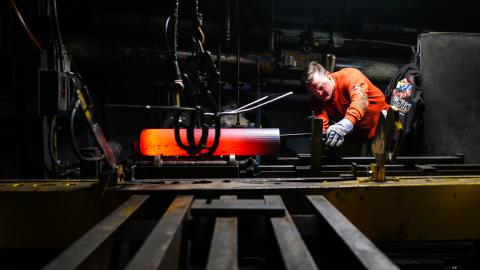
Chokeholds and Choices: Securing Supply Chains in the US-China Rivalry
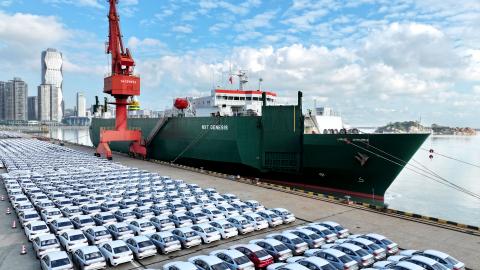

C.V. Starr Senior Fellow, Asia Studies, and Director, China Strategy Initiative, Council on Foreign Relations

Senior Partner, Tidal Wave Solutions

Associate Director, RAND China Research Center

Senior Fellow
Nadia Schadlow is a senior fellow at Hudson Institute and a co-chair of the Hamilton Commission on Securing America’s National Security Innovation Base.

Asia-Pacific Security Chair
Patrick M. Cronin is the Asia-Pacific security chair at Hudson Institute. His research analyzes salient strategic issues related to US national security goals in the Indo-Pacific region and globally.
The world’s two largest economies remain deeply interdependent even as they race toward greater self-sufficiency. Recently, the United States and China reached a fragile détente in their trade war, anchored by China’s agreement to resume rare earth magnet exports and America’s lifting of technology export controls. This captures the paradox of US-China competition: mutual reliance collides with mutual distrust as both sides build up their supply chains for critical minerals and advanced technology.
Beijing’s integrated control over rare earths and other processing chokepoints reflects a deliberate, long-term strategy. Meanwhile, Washington’s shifting mix of tariffs and export controls suggests a more reactive, ad hoc approach. Is that contrast real or overstated? What lessons have emerged from the COVID-19 pandemic, semiconductor shortages, and other disruptions? What more should the United States do—through reshoring, friend-shoring, and public–private partnerships—to forge a credible path to resilience? How might a US-China trade deal, potentially at a fall summit, alter this competition and the broader strategic rivalry? And finally, how can Washington leverage international relationships and tools like the Defense Production Act to secure its leadership in technology?
Senior Fellow Nadia Schadlow will join leading experts on supply chains and US-China competition for a panel discussion of these questions, moderated by Asia-Pacific Security Chair Patrick Cronin.
Event Transcript
This transcription is automatically generated and edited lightly for accuracy. Please excuse any errors.
Patrick Cronin:
Well, good afternoon and welcome to the Hudson Institute. I’m Patrick Cronin, Asia-Pacific Security Chair and it’s a privilege to moderate today’s panel discussion, which we’ve entitled Chokeholds and Choices: Securing Supply Chains in the US-China Rivalry. Our conversation today, this hour, will basically occur on two levels. The first, the immediate policy level, is about the upcoming summit between Xi Jinping and Donald Trump. The two leaders spoke last Friday and agreed on an American TikTok spinoff. Reciprocal state visits are planned for next year, and both leaders appear focused on consolidating trade progress, both limiting tariffs and easing the flow of Chinese rare earths critical to aircraft and electronics. In this November, in five weeks, the summit could open the door to expanded trade and even a measure of great power stability. So that’s the immediate policy level.
But the second level, one I’m maybe more interested in, is the strategic level. Beyond ongoing trade talks and diplomatic tactics, there’s a larger question about our government’s and China’s government’s action plan for achieving the specific aims of securing supply chains. How do tactics like withholding rare earth magnets or restricting advanced semiconductors fit into each nation’s plan on supply chain security? And is China succeeding? A decade ago, China seemed to shift its approach from pure growth targets to a laser focus on supply chains. More recently, it’s fourteenth five-year science, technology, and innovation plan designated five core technology hubs from Beijing all the way down to Guangdong along the eastern seaboard, more or less, of China, and the five form a clear north to south corridor, in fact, along this economic heartland of China and they’re adjacent to major ports and global trade routes. So they seem to have a coherent strategy.
And Xi Jinping has repeatedly stressed self-reliance, and he’s used a metaphor called overtaking on a curve to describe how a latecomer can leap ahead through technological change. China’s electric vehicle surge was the first proof of concept, and now China’s turned to semiconductors and to critical minerals. For Xi, independence and self-strengthening remain his guiding principles, building a safe, indigenous supply chain to protect industrial capacity and national security.
But what about the United States? This approach is both a mirror and a challenge for us after the wake-up calls of the past five years that we’re going to hear about, is the United States finally prepared to secure its own supply chains and rare earths and other vital sectors. Can we afford it? Are we ready to work more closely with trusted allies, like Japan, South Korea, and Australia? Industrial strategy is and can be at least a contentious issue, but one area where there seems to be broad agreement in the United States is over protecting our armed forces. Are we doing enough to act with urgency to safeguard the defense, innovation, and industrial base?
So we’re going to hear about these and other questions from four really outstanding panelists and experts. In reverse order, I’ll call on them at the far end, let me start with Nadia Schadlow who served as Deputy National Security Advisor for Strategy during the first Trump administration. and Dr. Schadlow is a senior fellow here at Hudson. She’s co-chair of the Hamilton Commission on Securing America’s National Security Innovation Base, and she’s highly in demand. Frankly, anybody who wants to figure out where is America going on national security strategy.
Rush Doshi, next to her, first served as deputy senior director for China and Taiwan at the National Security Council. He’s now C.V. Starr senior fellow for Asia studies and director of the China Strategy Initiative at the Council on Foreign Relations. And then to the right of Rush, Gerard DiPippo served as deputy national intelligence officer for economic issues at the National Intelligence Council. He’s now associate director at RAND China Research Center. And Cameron Johnson is a senior partner at Tidal Wave Solutions. He’s a long-time China-based executive working across multiple industries and he writes a great Substack blog called Decoupling.substack.com, which is focused on supply chain. So perfect for this topic, and that’s why I’m going to turn to Cameron first to kick us off, and I’m looking for some just very brief framing remarks on how each expert up here wants to approach this broad topic. But Cameron, having come from China so recently and going back so soon, we’re going to start with you.
Cameron Johnson:
I think when you look at supply chain broadly, just in terms of how China approaches it, China doesn’t necessarily pick a specific product. What they do is they try to seed the ground. And I will focus on five key areas, what I call five pillars of an integrated supply chain. On the first they focus on advanced infrastructure, not just ports and railroads, but things like 5G, the electrical grid, and sewer systems. The second is talent and the educational apparatus for that talent. It’s not just that you have to have people, but you have to find a way for them to be educated and trained, not just in university or trade schools, but also throughout their career. The third is government support, which in some cases is subsidies and others it’s tariffs, it’s land use regulations, and other things. Fourth is the raw material access and/or the ability to process. When you actually look at how China operates, they don’t have a lot of rare earths or raw materials, but they have absolute dominance in the processing and downstream. And the fifth is technology. And technology here is broadly in terms of companies and industries can use them to kind of propel themselves forward.
And China develops all of that. So to lay the groundwork when you talk like the new dragons out of Hangzhou, they didn’t pick those seven dragons and say, “We want you guys to win.” They just laid the groundwork and the foundation, and then whatever happened in the market happened in the market. So they approached it a little bit differently by trying to build out these areas of the ecosystem so then they can move forward. Patrick, to your point, a couple areas that they have focused on specifically, particularly President Xi the last I’d say five to 10 years, number one is the self-sufficiency. It’s absolutely a dominant force, not just in the discourse but in industry. We cannot rely on the foreigners; we have to figure out how to do it ourselves.
Secondly is the BRI, the new Belt and Road, won’t look like the last Belt and Road, but it’ll be much more targeted. For example, they’re connecting Kunming down to Singapore with a railway line. Then you’ll see some railroad spurs going off of that. So those kinds of things to help move trade around the region. And third is kind of the new productive forces. We no longer want to be a low-cost producer of goods. We want to actually move up the value chain. Things like chips to some degree, EVs, high-end machinery. The low-end stuff can be done in Southeast Asia or other places, but we want to move up the value chain. So, I would say kind of in my remarks, those are the three areas I would look at.
Patrick Cronin:
Fantastic. Gerard, over to you. For you, how would you frame these strategic issues as an expert on China?
Gerard DiPippo:
Well, similar to what Cameron was saying, I think the phrase I would start with is self-reliance. That’s the core of the recent economic strategy. I think sometimes when we have these conversations, people assume that China’s actions are much more externally oriented and focused than they actually are. I would always start with the internal and then look at the external. And the Chinese leadership believes that techno-industrial or high productivity, new quality productive forces, et cetera, that type of development is the key towards sustainable growth and becoming a developed and advanced economy. It’s arguably to production and manufacturing base, but that is, it’s a sincere view amongst Chinese leadership.
But in the past five or six years, as Cameron said, the focus on self-reliance has been in overdrive, and that’s because they are responding to external actions, namely the actions of the United States, particularly what happened in the first Trump administration with the trade war, but probably even more importantly with ZTE and Huawei where the US was trying to kill arguably China’s best tech company at the time and that freaked out the leadership. And also to Cameron’s point, it’s got a lot of local governments and private Chinese firms in line with that objective because they realize, oh wait, we actually can be cut off. It’s not just something that the center is saying.
The three buckets I would pose for self-reliance, similar to Cameron, would be technology and industry, which is probably getting the most attention. And there’s also commodities, so essentially energy but also food, and then financial, which is namely building up resiliency to US sanctions and having at least alternative rails for global RMB use.
You could debate whether these actions are defensive or offensive, but they have built up offensive capabilities in the sense that they have their own export control law and export control mechanisms that they’ve started since 2021. They have now used that against the US and other countries with rare earths. And I’m always hesitant to use the phrase “inflection point”, but you could argue that we just saw an inflection point, which is that China was able to use its own export controls against the United States in a trade war with rare earths, particularly with magnets, to arguably fight the US to a draw back to the negotiating table. That hasn’t happened before, at least with the US. And that leverage, at least over rare earths, is not going away in the medium term, even if you’re optimistic about US industrial policy. But in the longer term, China has other choke points that are developing because of their dominance in manufacturing.
Patrick Cronin:
Rush, you’ve in fact just come from teaching as well, so I know you’re a busy man indeed. But how in particular do you see this net assessment as well? In addition to focusing on China’s strategy and long game, is America building a long game here from your viewpoint? I mean, how are we doing?
Rush Doshi:
Yeah, I think the current situation is pretty serious and that China’s advantages are quite significant and they’ve been underestimated, as I think Gerard kind of helps lay out. What I would say is that, first of all, if you just look at US production versus Chinese production, China is two times US manufacturing value add. It is two times US power generation right now. Of course, a larger population. It’s three times US car production, it’s 11 times US steel production, it’s 20 times US cement production. If you look at key industries we care about, it’s three quarters to 90 percent of rare earth magnets, API and KSM for pharmaceuticals, as well as solar panels, drones, and so on. So it’s a pretty significant market position. A global market position in a lot of these sectors. And it’s actually ramping up production further. I mean, it’s not done establishing a commanding position in sector after sector. So these are just a few examples.
I mean, if you look at the installation of industrial robots in China, probably seven times as many were installed in China than the United States in the 2023 to 2024 period. So that’s a pretty significant investment in future productive capacity. And increasingly, they’re reducing the amount of labor that’s used in manufacturing as well with the investment in capital equipment. So put it all together and the story is not only do they have choke points, but they may get more in the period ahead unless the US and its allies and partners take decisive action.
Right now, if we talked about rare earth and rare earth magnets, that brings American industry to a halt in a very acute way. But there are other choke points we should talk about. One is pharmaceuticals. Again, I mentioned active pharmaceutical ingredients and key starting materials, but if you look down the list, fermented API, it’s antibiotics, if anybody in this room took one in the last month or so, you don’t have to tell me, HIPAA protects you, but ultimately a lot of the material for that came from China. The same thing is true for Heparin. If you were in a hospital, got an IV, if someone you know got kidney dialysis, the functioning of our hospital system entirely depends on goods provided by China. Those things can be changed, but it will take time.
Which is where I’ll end, Patrick, with this. I’ve written a series of articles where I think the path forward is, yes, American domestic investment and renewal, but also a quick surge to American and allied scale. China is so powerful because it outscales the United States. If the US is able to achieve scale with its allies, it’s not even a contest. And let me just give you some stats very quickly. The US and its allies would have 50 percent more production capacity than China value add. They would also be far ahead in the domination of active patents, top-sided publications, they would have a GDP that’s 50 to three times as large, depending on nominal and real statistics. 50 percent, basically, to 100 percent. It’s a significant increase in US capability when you add allies and partners. So, the only path to industrialization, re-industrialization, the only path to avoiding these dependencies, is going to be in common with others
Patrick Cronin:
Rush, excellent. So, Nadia, I mean, from your point of view in particular, you’re trying to protect our defense innovation, industrial enterprise. How are we doing? What should we be asking in response to what China’s doing on this issue and what do you know that we’re ... how do you view this issue? What’s your assessment of the US?
Nadia Schadlow:
Well, we’re not doing well, and I agree with everything that Rush has said, and although I’ll actually probably even be a bit more negative in the sense that we’ve been looking at this problem seriously for decades in many ways, but certainly at the very least since 2017, when I had the opportunity to work on the national security strategy at that time, one of the key points in it was ... it asked a very simple question, how can we depend upon one of our most serious rivals, China at the time, a strategic competitor we called it, for most of our defense inputs, right? I mean, it doesn’t make sense. It didn’t make sense then. It doesn’t make sense now. The problem is if you go back further, we’ve identified this problem for many, many years. The problem of critical minerals, for instance, has been identified as a vulnerability for close to 30 years.
The API problem in medical supply chains that Rush mentioned has been identified for at least 10 years, at least, if not more. So if you go back through all of these problems, and it’s all documented, it’s all there in government reports, not even think tank analysts, actual government reports, we’re seeing the same identification of the problem over and over. So I think you have to approach things in a positive way because you don’t really end up with good outcomes if you approach everything negatively. But it is hard to stay positive in thinking about what is the modality that we need to really shift things.
So while I appreciate Rush’s point completely about scale, what worries me a little bit, and I don’t mean this in a way at all that ... we need our allies, is that we’re adding more complexity to the problem once we ... So what worries me is we’re having trouble pulling this together ourselves in many ways and add on allies and the operational complexity of moving to better outcomes worries me. We need to do it, for Rush’s point on scale. We absolutely need to. But we also need now to be quite specific about the modalities to get to where we want to get to. And I can sort of say more on that. I have an acronym that I want to introduce later.
Patrick Cronin:
Excellent.
Nadia Schadlow:
Hold off.
Patrick Cronin:
Well, those are great opening strategic framing remarks from all of you. I want to just come back to each of you on an issue. I mean, Cameron is one of the reasons US may not be responding effectively and strategically is because of the cost? I mean, can we afford to do this? Who is absorbing the costs and how do we compete with the government support that you talked about from China to their industries?
Cameron Johnson:
You can definitely compete with the government support. I think there are some lower-hanging fruits, for example, long-term contract runs. When you actually look at how contracts are done, you need five, 10, 15, 20-year runways. And it was interesting, the most recent deal done with MP Materials, because you saw some of those price floors as well as the length of term. But I generally don’t think that the United States is prepared to pay the cost of what it would actually take. And the primary reason is this is a beautiful N95 mask. We all remember these from the pandemic. American. ...
Patrick Cronin:
It’s a prop.
Cameron Johnson:
It is a prop. Sorry.
Cameron Johnson:
Ahead of a curve. Yeah. During the pandemic, American organizations would not pay a single penny more for a mask made in the US than China and Americans died. And if you’re not wanting to pay a penny more for a product to save somebody’s life, you’re never going to do it for anything else.
Second prop, sorry, Rush, I appreciate it, is this beautiful MAGA made in America hat. Guess where it’s made. Made in China.
Patrick Cronin:
But we own the IP, right?
Cameron Johnson:
Apparently. Apparently. The challenge I have in this discussion is of course we want to reshore stuff and absolutely, I completely agree. The challenge is that when you actually look at the costs of doing so, people aren’t going to pay it. And there are some things you can do, longer government contracts, as Rush said, you can definitely work with allies and partners. But it is an absolute cost. And if you’re not willing to do it for this stuff, which actually is not that much cost, how are you going to do it for anything else? And so that’s kind of where I land on that. In terms of longer term, I’m a bit more positive in Rush’s domain of if we do get some of these actions or partnerships with allies, you definitely can do some stuff, but let’s make no mistake. Again, people died. And right now in this country, there’s a PPE shortage. There should not be a PPE shortage after what we just went through.
There was a hundred and some factories opened up for PPE manufacturing in this country. There’s four left. Again, so if I’m a business wanting to contribute to either the build out of defense or rare earths or critical, whatever it may be, and I look at the billions of dollars spent in that area and say, “I didn’t get any support, nobody wanted to buy my product, it was too expensive and they’d rather just buy from somebody else, particularly China,” I’m not going to invest my money. And that’s today. So how do we fix these problems? If we can fix this problem, we can start to fix the rest. But this is really the issue. Sorry for the downer, Patrick.
Patrick Cronin:
No, no. Thank you for the props. Gerard, I know you want to focus on the internal first before you look at the external, but when China’s looking at its partners in sort of these issues, some of the things I see across the border are pollution in Cambodia and Laos. I mean, they’re able to go in there, they don’t have any of the kind of environmental challenges that we do in the United States or in other democracies, and they’re able to just act and move very quickly and achieve scale. But how do you see China’s enterprise in terms of how they’re using, whether it’s on the periphery or in other countries around the world, Pakistan or East Africa for critical minerals, for big pharma, for whatever other areas or potential choke holds?
Gerard DiPippo:
Yeah, I would differentiate between foreign sources of inputs, like critical minerals, like cobalt in the DRC, for example, versus foreign markets for Chinese goods. Those are two very different situations. China’s desire to acquire or at least secure foreign inputs goes back over 20 years in a strong way. That’s not new. What is different is that their companies now need external markets more in part because the domestic market in many cases is saturated. A lot of Chinese investment has been in Southeast Asia in manufacturing, Vietnam in particular. Most of that is not for the Vietnamese market, it’s just a new hub.
The Chinese government is actually kind of lukewarm in this because the previous five-year plans were more open to the idea of losing lower value-added production in China. But the fourteenth five-year plan is more about whole-of-value chain security. So even if things like a mask is a very low value-added product, there’s an obvious reason you want to have that capability, right? So, you want to retain that.
I think a lot of China’s relations, particularly outside of Asia, are fundamentally economically-oriented and a lot of that is just sort of downstream of what they consider their domestic development needs as being. Just as a quick side point to maybe be less of a downer, if we are worried about the US’s and its allies’ ability to resist coercive tools like China, say, not exporting rare earths, in particular cases, that might be quite difficult. But if you think about the aggregate, something like, as Rush said, yes, China’s manufacturing sector is double what the US is, but 70 to 75 percent of it’s for domestic use, so only a quarter of it’s going overseas.
So the US to, quote, “compete”, or at least be secure, does not have to replace all of China’s production. It only has to replace the part that is going to the US, which is a much smaller subset of that 25 percent going externally. So I think there are particular fields like rare earths, like semiconductors, things that the Biden administration had early on in its supply chain review, that you need to focus on those choke holds. But it is not the case that the US needs to have anything like China’s scale in, say, steel production. We don’t have a massive, well, China’s housing bubble has burst, but we didn’t have massive construction the way they did for the past 20 years. So you have to scale it to what your actual demands are.
Patrick Cronin:
Excellent. Rush, when you see the current impasse that the two leaders are trying to overcome and seem to be close to some type of modus vivendi, I mean, it’s coming at a cost of changing our views on providing chips H20 chips, or who controls the content recommendation algorithm from ByteDance, or going back to your administration and the whole mantra of small yard, high fence. How do you see US policy evolving on trying to stem the flow of some of these technologies and how effective are these export controls and other measures?
Rush Doshi:
I think the export controls on compute work, despite claims of the contrary. I think the reason they work is because China can’t produce those chips at scale, the ones that are leading edge, and even some of the ones that are not leading edge, they’re still producing them using largely American equipment. Maybe in a few years they won’t need that equipment for the second tier chips, but the first tier they can’t make. And so when you hear from an AI company that we’ve got to sell these chips to China to get them addicted to our supply, first of all, just commend to you President Xi’s own words that he has zero desire to be dependent on those chips. Second, that any chip you sell to China in some ways is a chip you don’t sell to an American company. And third, I guess fundamentally, I think a lot of our chip companies are doing pretty well financially because certainly their market capitalization is up 10x since the export controls came into place.
So, I don’t see the need to relax the controls; otherwise, China somehow becomes even more formidable. They’re already formidable. And the one area of American singular advantage in this competition, given all the industrial disadvantage, happens to be this thing called computing. And it happens to be that that thing called compute is the most critical input in the next generation of leading technology, which is AI. So, we got lucky, and we should not squander our luck to make $15 billion a year in extra profits that we could have had, selling to American companies anyway.
Put that aside for a second, though. There’s a lot of defeatism, a lot of defeatism, because we have had these problems for a long time. But you know what we haven’t had is a consensus that we had the problems. We had people write reports, but no one read them. We had politicians talk about other issues; nobody talked about this. Now we are having a conversation about this across the country, now we have investment leading the way in innovative approaches to solve our problems. America can fix this because, as Gerard mentions, we don’t have to replace everything China’s got.
So let me just offer three optimistic points, because I think if we don’t offer them, people will say, “Shouldn’t we just do President Trump’s grand bargain with China and call it a day?” And here’s why I don’t think we should do that. First of all, I think it’s critical to note there is no path, no path to sustaining American manufacturing, I think, in the world without being able to sell to third country markets. You can’t just do it on the domestic side. And if China wins in every third country market, then everybody loses. So, there’s a lot of incentive for countries to come together and create a wall or a moat or something that gives everybody in the club better terms than China, which should stay outside it.
Second of all, look at the critical mineral. Look at APIs, look at pharma. America, for all of its problems, which we’re trying to solve now on being able to scale up production, America is not going to be able to produce fermented API like that, but other countries can go pretty quickly. Japan and Korea right now are leading the way on stuff like Heparin, and India has capacity in API. And if we’re able to really work together and have capital flow more naturally and have people guaranteed to be able to have offtake for those markets to sustain, then I think you can find a way to do this in common. But there is no other way. So as complex as it is, it’s the only shot we have.
And then the third point I would say, is do not discount the fact that manufacturing’s changing, that it’s less labor-intensive than it used to be. If it’s true that a Chinese auto plant can work with just a handful of the factory workers that it would’ve required 10 years ago, why can’t American manufacture? Why can’t we do it even if our labor costs are higher? We don’t have the tacit knowledge, we don’t know how. Where’s that going to come from? Again, our allies and partners, they know how. You want to build cars? Talk to Japan and Korea. You want to build ships? Talk to Japan and Korea. You want to build chips? Talk to Taiwan. You want to build medicine? Well, Europeans produce it at scale, Europeans, Indians, Japanese, Koreans, that’s your path.
So we have to find a way to do both, domestic reform and international co-production. And I don’t think it’s impossible because every other country faces the same thing we do, forcible de-industrialization. And Cameron’s point is it’s too expensive for us to do these things, but there’s a reason why. Yes, we have regulation, yes, we have permitting problems, yes, we have high energy costs, yes, we have high labor costs, but there’s a simpler reason why. China is a predator, and they are pursuing predatory capitalism. And unless we get together and raise the wall a little bit, it’ll never make sense to manufacture in any of these other countries.
Patrick Cronin:
So, Nadia, I mean, Rush has, I think, underscored your point, which is there is a consensus on the problem. We’ve known the problem on the defense side. What are we doing about it now? What do we need to do?
Nadia Schadlow:
Well, I think his point, Cameron’s too, is an element of it’s not completely cost. There’s also, I think, disagreement about some of the modalities of how to do this, right? And we have my colleagues in the audience, you have more free market-oriented, the private sector has to drive it, government, but how? What are the modalities? And that’s where my acronym comes in, because in thinking through how do we take this problem of defense industrial base, it’s a big, complex problem. I was thinking, sort of, how do you break it down, or how do I break it down? And I break it down sort of in four ways.
The first understanding. We have an understanding of the problem, which I think we do, and Rush and others have pointed that out. We have had it for years, and there are countless assessments. I just finished a report on the Defense Production Act and went back to the Department of Commerce, their BIS office has done assessments of our defense industrial base for decades. So go back and look at them, and you’ll be somewhat discouraged because there’s an old shipbuilding one in there from decades ago. We have an understanding of the problem.
Visibility. We have more visibility into the supply chain problems because of experts right here in the audience, and also AI. So, we can crack the code a little bit more on the 200,000-plus suppliers of US defense products, which is a GAO number. We’re in a better situation today to have the visibility than we had before, and some of that is AI and computing and our ability.
Objectives. This is where, though, I think we start to get a little bit shaky. I’m not sure we have an agreement on the objectives that we want. How much is enough? How much do we need to produce here? How do we produce here? And what sectors do we need to focus on? I think some people have the answers, some people have articulated powerful answers, but I think we’re still sort of now a little bit in the gray area of objectives. What are we really seeking to achieve in these particular sectors? When will we know we’re less dependent? What are the numbers?
And then finally, the last modalities, where I think we’re still struggling. What modalities are best suited? It was mentioned purchases, purchase commitments. I just learned from this DPA research that the Defense Production Act allows pretty four powerful instruments: loans, loan guarantees, purchases, and purchase commitments. Do you know how often those are used? Virtually never, right? Except for during COVID, when we used purchase guarantees, which were a critical reason why Operation Warp Speed was able to bring vaccines online so quickly. We don’t use those, right? So that’s an example of just not being clear about the modalities and yet purchase commitments are critical.
If you talk to anyone out there in this space, young companies, the go-getters, the innovators, they often say, “We don’t need the government’s help. We just need them to buy the products that they promised they would buy.” So these are examples of how we can do better, and we need to do better, but we need to kind of fix those, too. And so, if you do the acronym, it’s UVOM, which is a terrible acronym. Understanding, Visibility, Objective, and Modality.
Patrick Cronin:
And Rush, jump in.
Rush Doshi:
Can you do MOUV or something?
Nadia Schadlow:
Yeah. Then I was thinking, yeah, we’ll work on this after the panel.
Rush Doshi:
After the panel. I just want to just foot-stomp everything that Nadia just said. And I’m on the left and we still agree. But my basic point is this: offtake or purchase guarantees is critical. When you look at the scaling up in World War II that the US was able to do, this was a big part of the equation, that people knew if they were able to produce certain things at certain scale, it would get bought. And so you had credibility and certainty when you made that investment. Right now, take rare earths. We tried to get $2 billion worth of money for purchase commitments from Congress in the Biden administration, and we were shot down because Congress lives in an appropriation-starved environment, and as a direct result, we don’t have the money we need to spend on these things. Two billion USD might’ve been able to help us turn the tide on where we are today with China on rare earth magnets, but we didn’t spend it.
Now, Congress can change its view. And also on top of that, you can use the Defense Production Act if there’s sufficient funds there, but look at O-Triple-B. Look at that Big Beautiful Bill. What did it have on rare earths? Now, I’m going to give credit to my friends who worked on this. It has a lot of loan guarantees. That’s supply side. But on demand, it has nothing to set the price floor for rare earth. There’s the MP deal, that’s great, but not at scale. Nothing to make it easier for you to know that when you put that dollar of investment, you open that mine, that when you get that stuff out or you refine it, that somebody’s going to buy it at a price. And if you don’t have a price floor, what happens as China undercuts you.
So every time we get close, they come, and they flood the market, and they undercut you. That is predatory capitalism. We let it happen because there isn’t a tariff. There wasn’t historically a tariff that would stop it from happening. So again, I don’t think this isn’t impossible for us to do. In rare earths, we’re not talking about 21st-century technology. We can do this. We just have to find a way to structure, as Nadia was mentioning, our institutions, and those laws are on the books, to be able to tackle this problem. We probably have to walk away from some of our ideological precepts on free market capitalism, which it’s overdue.
Nadia Schadlow:
But, I mean, Rush is right.
Rush Doshi:
On the left.
Nadia Schadlow:
The authorities are there.
Rush Doshi:
Authorities are there.
Nadia Schadlow:
They’re there. They’re at DOD, they’re there, Congress has give- ... Yeah.
Rush Doshi:
And Defense Production Act comes from the 1941, 1942. And so this is legislation, this is an approach that we thought made sense almost a hundred years ago.
Patrick Cronin:
Fantastic. I hate to interrupt this agreement. I want to come back to China a little bit and ask Cameron and Gerard to some extent on expectations of what do you think China wants out of a deal with the United States right now in the short term, and how important is the supply chain as part of that? But what exactly is China looking? And maybe also Cameron, just because you’re coming from the ground, what’s your assessment on the ground of how China’s economy is going? And Gerard, do we have the data? How do we know, when those buildings are empty, that they’re permanently empty or they’re going to be used for something else or maybe it doesn’t matter?
Cameron Johnson:
Thanks for the easy question.
Gerard DiPippo:
Take the political one first.
Cameron Johnson:
Yeah, I mean, China’s economy is not what it used to be. If you are in certain industries, AI, semis, EV to some degree, you’re doing okay, if not better. If you’re in more traditional ones, retail, lower-end manufacturing, unless you’re Labubu, it’s a struggle. And I think part of the challenge generally, for business anyway, is basically up until 2020, I’d say between WTO session in 2020, businesses generally know where to go and what to do. It’s real estate, it’s infrastructure, it’s retail, it’s Starbucks and McDonald’s, it’s Disneyland, go. And we all generally knew where to go and what to do.
Now it’s unclear. And doing high productive forces does not quite give you the guidance that that did. On top of that, the world has changed. There’s a lot more tension, there’s a lot more apprehension to invest in certain areas because maybe it’s over capacity, maybe it’s, “I’m not sure if my product will sell.” But so the economy in my view is just kind of muddling along. I don’t remember the rest of your question, but that’s where I put ... Gerard, what do you think? You’re the data guy. Tell us. Tell me I’m right.
Gerard DiPippo:
You are correct. I would say just on the Chinese economy, the central story is the property sector, which we don’t like talking about here because foreign money is basically not involved in that. But China, before COVID, it was something like 25 or 30 percent of the economy was directly or indirectly linked to the property sector. They’ve had the largest absolute contraction in property construction ever because it was the biggest boom in construction ever. And that has been something, at least 10 percentage points of GDP reduction if not more in the property sector. And that’s what’s killing sentiment, because that’s everyone’s savings. People don’t typically, until maybe of late, invest in the stock market. And that’s why consumption is weak. Until that recovers, I think discussion of consumption stimulus is mostly feckless. Chinese scholars or economists will say at least another two years, some say five years.
As an aside, I think China is repeating a slightly less bad version of Japan’s mistake of the 1990s by not dealing with the problem decisively. To your first question, Patrick, what does China want in the trade talks? I think it’s basically three things. One, they want tariffs lower. You could debate how much lower, but generally depends on all tariffs they want to get rid of. The second thing is in export controls. Their dream is that there would be no restrictions on lithography machines. That’s probably not going to happen. But maybe slightly more doable would be high-end chips. And then third is not that related to economics, which is Taiwan. They want specific language where the US and our president opposes Taiwan independence as opposed to does not support, which is a slight semantic distinction that might matter to some people.
Cameron Johnson:
If I can just add, Patrick, on the consumer sentiment, it’s probably the lowest in recorded history. And part of the challenge is particularly people my age, which is 25 and a half, is that the social security net generally started in the late ‘90s. And so there hasn’t been the runway like here, for example, social security, Medicare, generations, there’s only been really a generation. And much of that because particularly on the local government level, because money has been spent in other areas, it’s now quite challenged.
I’d say the most impactful domestic ruling in the last year has been the People’s Supreme Court in Beijing where they ruled that you have to contribute to the social welfare systems, whereas before, if you worked, you can kind of negotiate with your employer, do I contribute, do I not? Now it’s absolutely mandatory across the board in the whole country. And part of the reason for that is because these systems don’t have as much money as they need.
That also contributes into consumer sentiment because consumers know that this train is coming and they have to save more money in order to be more secure. And so they’re also not spending, except for maybe Labubu. So this is also something that in the dynamic along with the real estate, along with a few other factors, employment is not as generous as it used to be, it’s not as plentiful as it used to be. And so these are some of the challenges as well contributing just to kind of the unease in the society and the markets.
Patrick Cronin:
Hmm. A lot of issues I want to talk about. Rush, I don’t want to overload you on this, but in terms of the talent pool and visas and where we draw the line on talent, I mean, what is your reaction to how well we’re doing to try to protect our national security apparatus and research labs, but at the same time bring in the talent that we want and keep the talent?
Rush Doshi:
There’s an interesting question about whether the United States needs high-skilled labor anymore. I didn’t know that that question was one that people really wanted to ask. I thought that the singular superpower of the United States is in a world where you are five percent of the world’s population and you don’t have the ability to achieve the kind of scale that a country that has 1.4 billion people can achieve, you’re going to have to find the best and brightest, yes, at home, you’re going to have to cultivate them, but you’re also going to have to find them abroad.
One of the interesting contradictions of the coalition that is opposed to high-skills immigration is they say, “Don’t import foreign scientists.” Full stop. But the second part of that is, if you don’t import them, you should increase scientific funding at home so you can actually make it livable to be a scientist. But the truth is how do scientists get paid? Largely by federal grants. And what did we do? We cut the grants. So if it were a serious credible argument that you want to invest in America’s scientific capability, then you would have increased spending in domestic science and research through US government institutions.
People say, “Well, actually, look, Rush, the space program was built with only a few high-skill immigrants at the very top. You didn’t have a large number of them as part the program.” And that’s sort of true. There’s an element of truth to that. Of course, you did have a large number of European emigres before that that came because they were escaping anti-Semitism in Europe. But put that aside, let’s grant the full ahistoric argument that critics make. The reality is that even in America back then, universities like Grinnell College were leaders in engineering, they were ahead of the curve because the US was investing in it.
And if we don’t invest in our science and technology ecosystem and you don’t decide to import some foreign scientists to help you get even better, achieve greater scale, then you’re just ceding scientific competition to China. And meanwhile, China has created a new visa, a visa designed to attract high-skilled immigrants from around the world, people perhaps who are less worried about the political environment in Beijing. So how are we doing on the talent competition? Well, America has every advantage that you could possibly ask for in the talent competition, and we’re walking away from it today. But I do have faith that it’s possible that some of this can be reversed, because I think the argument in favor of high-skilled immigration to the country is overwhelming, but the politics is changing and we have to be honest about that.
Patrick Cronin:
Nadia, before we turn to the audience for some questions, when you think about the Trump administration’s thinking about decoupling, where do you think the administration is on this broad topic, whether it’s regarding supply chains or more broadly on decoupling and de-risking, whatever term we’ve used in the past? Are we using those terms now?
Nadia Schadlow:
I haven’t seen the terms being used explicitly. I mean, I think there’s probably, like any administration, I think there are divisions now in how to handle the US-China competition, but in the end, I don’t think the president wants to see himself backed into a corner. I think, ultimately, he wants freedom of action that this conversation will allow us to achieve, an industrial base that can produce for our military, but also for the American people. So I don’t think in the end he wants an objective which leaves us cornered.
I think the challenge is we’re kind of having two conversations in a way. One is how do we fix legacy problems? And another is looking forward to how do we make sure we don’t make the same mistakes in emerging industries, right? And on the latter category, I would put advanced manufacturing and robotics, I would put diversified energy sources, whether it’s nuclear, whether it’s fusion energy, which has a whole supply chain issue as well related to that issue. If we lose out, if we make the same mistakes in these forward-looking industries and opportunities, we will really be in trouble. But we have opportunities not to, for the reasons we spoke about in the panel.
At the same time, and we do have to do things simultaneously, we need to fix some of the legacy problems that ... I’m not going to get into the talent issue, but part of the problem for the past 50 years has been the decline of American’ education system, which got us to where we are in the first place. So in that post-war Manhattan Project period, American kids could add, okay? They were adding. Today, they can’t and they can’t read. And those statistics, they’re out there, they’re declining, and they’ve been declining across bipartisan administrations. So we have a fundamentally different problem today, and part of the reason we need this talent is we’re not producing it because of a really broken school system that is ... luckily I don’t do domestic policy or I’d really have an aneurysm.
Patrick Cronin:
Rush, did you want to-
Rush Doshi:
Just very quickly. I mean, I do think that a lot of the problems that we have cannot be solved by the president. They can’t be solved by the executive branch. These are problems that are fundamentally democratic in nature. They are problems that have to be solved by our most democratic body, our most democratic branch, which is Congress. If Congress is dysfunctional, as it has been for 25 years or more, it’s not surprising that we can’t rise to the occasion of these new challenges. If Congress can get behind in a bipartisan way, as we’ve seen increasingly, solutions to these problems, whether that’s education or whether that’s using the Defense Production Act in more important ways, we can solve these problems. So it all starts in a democracy with the voters, and it starts with Congress.
Patrick Cronin:
Well, with that preamble, let’s turn to the audience. We have a microphone that will come up to you. When I call on you, please just introduce yourself and ask a brief question or make a brief comment. We’ll start with the gentleman in the back since he’s closest to the mic.
Audience member Mark:
Thank you. My name’s Mark. I’m from United Daily News. We’re based in Taiwan. So my first question is to Gerard. You mentioned that China wants three things: tariffs, lower export control, maybe, and Taiwan. So I’m just wondering what’s more prioritized on that list? And also I keep on hearing about allies and co-production to allow America to scale up production, but I’m just wondering, with the current administration’s policies, we kind of just kind of pressuring our allies and is that the ideal balance right now? How can we make it better? Thank you.
Patrick Cronin:
Right, and we’re actually going to collect three questions at a time just because we’ve got a limited amount of time. So we’re going to come all the way up front here. We’ve got two questions. Either order doesn’t really matter. This gentleman.
Audience member Jackson Lopez:
Hi, my name’s Jackson Lopez. I’m with the Oxford AI Governance Initiative. I’ve got a question for Rush and Nadia. We’re obviously in a very special moment right now where we can export compute and the Chinese really can’t, but as China begins to expand its domestic capacity, we can probably expect some kind of BRI style where there are chips they’re exporting en masse, data centers, which they’re already building abroad, but for that to scale up. By that point, how can the United States strategically compete for dependency on its technology? What are the carrots and sticks we’ll still have access to when that day comes?
Patrick Cronin:
So that’s the future question. One of them. Yes, ma’am. Right here in front, as well. The third question, then we’ll turn back to the panel.
Audience member Shirley Hargis:
I’m Shirley Hargis, I’m the AI policy and governance lead in Defense. So my question is for Rush and Nadia. Nadia, when you were outlining your acronym, you spoke about the modalities piece, and it makes me recall some of the pieces you’ve written about more effective ways to slice through to get to policy, make it faster. When you’re speaking about the modalities, are those one of the top concerns that you have, about how we can, yes, we’re dealing with all these legacy problems, but is that one of the ones that we are not focusing enough on, how to slice through policy? And for you, Rush, you mentioned that the US has a strong pulse on compute, and I know with compute that’s how you fuel your models. So do you think that our thumb on compute is more important than, or help me find how you want to measure this, but is that more important than ... does that minimize or balance the concern that we have about talent, the comparisons and talent here versus in China, the dominance that China has in legacy chips versus the dominance that we have in more advanced chips?
Patrick Cronin:
These are pretty sophisticated questions, but I don’t know if Rush and Nadia, we want to start with you first since we had the last two questions were directed at you.
Nadia Schadlow:
I’ll just address Shirley’s last point. I think with the modality issue, policymakers need to ask a simple question: why have we failed in the past? Why? What is the reason why these past efforts have failed? Partly, we don’t ask that question because we have quite a polarized political environment, and so there’s a tendency often to not recognize that your predecessor might’ve tried to do something positive and similar to what you’re trying to do. But in asking the why, a good example today is permitting reform. We’re consistently asking the why. A consistent answer is permitting reform for a lot of these re-industrialization projects. And now we have some important bipartisan legislation out there. One is ERPA, the Energy something Permitting Reform Act, bipartisan. So these pieces of legislation need to pass, and then we need to hold people accountable to doing them. So it is an element of the modality. It’s what tools do we have? Why aren’t we using them? Again, the why question. And why have we failed in the past? And asking your staff to come up with those specific answers. Where are the obstacles? And then we can drive forward more effectively.
Patrick Cronin:
Rush, a lot was focused on compute, and as somebody who teaches at Carnegie Mellon University, president of the university, Farnam Jahanian, focuses on compute, compute, compute. So it’s driving so much of the research. But also the potential as a Belt and Road Initiative type of exercise, and where that leads us in terms of competition in the future is a fascinating future question. So, your response?
Rush Doshi:
Yeah, I’ll come to that. There’s also a question in the back about can the Trump administration build allied scale, essentially? That’s the term that I like to use, allied scale. I actually think the answer is yes. I think the Biden approach did emphasize persuasion. Sometimes that reached a limit. Coercion is another approach that can create progress. Of course, it might create concessions in the short term, but over the long term, it can create distrust. But we are seeing signs before some recent policy missteps that countries like Korea are willing to put tons and tons of money into US shipbuilding, for example, and they have more productive workers and better technology and better techniques for shipbuilding that are making them maybe two to three times more productive than we are per person. So if you take that and you bring it here, that’s the transfer of knowledge to the United States in a way that could improve the productivity of our sector, even without a massive market that we can sell into. So that’s the kind of progress that the Trump administration is sort of making, can make, and I hope they continue to make.
On the question of compute and the Belt and Road, this is a very important question. We have to ask ourselves right now, if you were China, what would you want if you wanted to build a Belt and Road of AI, essentially, what does that mean in practice? China currently owns a lot of the parts of the tech stack that’d be relevant for doing this. They already own what we call the edge. They make all the phones and all of the laptops and everything else that might matter at the edge. But if you want the model to work, you need chips that can do inference. That’s what you need to have. And the best inference chips are definitely American, and it’s not even close yet.
And even if they wanted to scale up on inference production, our US government estimates suggest they can only make maybe 200,000 or so of the Huawei Ascent. Just so you put that in context. That’s less than you might have in one really major American data center. That’s the whole national production. Give them some time, maybe they’ll be able to increase that amount, but today is when those models are going to become nodal. Not tomorrow. Today is when we determine the app layer. So it’s like, well, maybe they can catch up on an operating system. Let’s imagine as Microsoft versus Horizon 20 years ago, Horizon didn’t exist then, but we were the first mover, and so we established a fairly dominant position. Right now, there is an opportunity to own the app layer of artificial intelligence, and we are best positioned to do that unless we give that advantage away.
If you unlock the ability to sell these chips to China, they have good open source models. They already own the electronics. They have the ability to make great deals with countries all around the world. You throw in the inference for compute and they will dominate the app layer. They will. It’ll be bigger than the Belt and Road. But right now, that’s not possible.
So to me, part of the export controls is about timing. The timing is fortuitous for us to make right choices, the question is if we will. Now, I will be wrong in everything that I said if the following conditions obtain, if China is able to indigenously produce equivalent chips at scale, then I’m wrong. But so far and the leading experts in the area, including the USG experts, don’t believe that’s possible. Premier Li Qiang doesn’t seem to believe that’s possible. The CEO of DeepSeek doesn’t seem to believe that’s possible. So right now, I don’t think I’m wrong but stand to be corrected. And I think that hopefully addresses your question as well about the kind of advantages that China has in some areas, yes, of the stack, that’s significant, but the areas that might matter for winning the app layer of artificial intelligence, they don’t have that yet.
Nadia Schadlow:
Just one quick add, Rush. The only thing is even on the technology, the tech dominance side, the competition side, China also has an infrastructure, digital infrastructure-forward concept of how it wants to drive development around the world, and I don’t think we do.
Rush Doshi:
Yeah, I would agree with that, and I would just say that that’s all the more reason why it’s important to make sure that the app layer is American.
Gerard DiPippo:
Right. Just on the question of priorities among tariffs, export controls in Taiwan, the short answer is I don’t know, but they’re all obviously priorities, but I could speculate which is the most urgent. I think it’s tariffs and it’s not because the trade war is hurting so much, it’s that if you got tariff relief in say a year or two, it doesn’t matter as much because markets have already adjusted, so insofar as they’re going to get any gains from that, they want it to be removed quickly because tariffs tend to be sticky and the markets are going to adjust. Export controls would be sort of the next on that.
I think to Rush’s point, they are compute-constrained. Their discourse with AI is much, and their AI Plus plan is much more diffusion based. Part of that I think is due to those constraints, but I think it’s also a maybe fundamentally different view as to how technology is going to be deployed, that they think it’s just having second best, but quick enough and everywhere is better than having the leading edge. I was at a public event with Anthropic last year, or last week rather, where they called diffusion a sideshow. That is not how the Chinese government sees it. And so, I think for them, export controls are sort of more of a medium-term issue.
And Taiwan is the big strategic issue, that’s not going away. But as Chinese interlocutors would say, this is something they have shelved for the early part of this Trump administration, so they can wait if needed, but obviously that arguably matters the most of the all three in the long term.
Patrick Cronin:
Cameron, anything to add to any of this?
Cameron Johnson:
I would just say on the AI, I agree that the US will have absolute dominance for a while anyway in breakthroughs and usage, but China will have dominance in adoption, application, and diffusion. And I’ll give you an example of a company I work with in China, large consumer goods manufacturer. They’re using DeepSeek and like-minded programs in the factory. And I was quite stunned because this is a consumer goods manufacturer. They normally don’t do that. And I asked them and they said, “Well, business is slow. So we’re having our IT teams check this and try to figure out what we can get through it or get from it.”
In their WeChat groups, they have hundreds of people all along the value chain, all the way from the raw material producer, their packaging guys, the plastic guys, all the way down to the OEM, all talking about how are we using DeepSeek and these programs, things like, “I put my production data in, then I put my staffing data, then I put my logistics data, and look at all the stuff I’m getting. These five machines on this product were terrible, on these particular shifts they work great.” So they’re getting much more operational drive from it. And that really is kind of just the beginning. When you start to see that across ... it’s just one company, across entire chains, I guarantee you Boeing’s not doing that and neither is Dow.
So I agree the US is ahead, but the problem is that I see is that as that becomes more ingrained, it doesn’t really matter to me if a data center has US or Chinese chips. I mean, it might in the aggregate, but in my world it doesn’t. In my world it really depends who are the guys on the ground who are just crunching business data going to use. And at least in China and the Chinese supply chains, it’s going to be Huawei and other chips just because they’re cheaper, they’re easier, and they know what programs to run on them for the best efficiency.
Patrick Cronin:
That’s fascinating. I think we have time for one or two questions or for brief, these two gentlemen I think right here.
Audience Member:
My question is about would it ever be appropriate or what do you guys make of the argument that, if we’re behind China in all these different industries, shouldn’t we do exactly what they did when they were behind, which is invite the very best foreign producers, which in many cases are Chinese, and to do joint production with Chinese companies, at least in some cases? We know the concerns about that, but I mean, for example, EVs, the Japanese and the South Koreans aren’t necessarily the best. So if we want to be the best, don’t we have to work with the best, just the way that China traded market access for our technology in a previous era?
Patrick Cronin:
And this gentleman over here in the middle.
Audience Member Mikhail:
Hi. First of all, thank you guys for making the time to come here. I’m Mikhail. I’m from the Washington International Trade Association. And I wanted to ask, my question aimed towards Rush. You mentioned a lot about building allied scale. I wanted to ask more about the United States’s position in that solution in the sense that do our allies require the United States to build allied scale or is the United States right now supposed to be acting as an interlocutor and are they acting right now as a missing link?
Patrick Cronin:
Was there a third question over here? Did I see a hand over here? Did somebody want to come in? Yes. Yes sir. Tom. Dr. Duesterberg. Mic is coming. You get the final question.
Tom Duesterberg:
Okay. Tom Duesterberg, Hudson Institute. All of you argued that China’s long-term goal is self-sufficiency, but also alluded to more or less a lack of purchasing power in China. High unemployment, no social welfare system, and also alluded to Chinese capitalism as predatory capitalism. So at the moment, China needs foreign markets and there seems to be a contradiction between their goal of achieving self-sufficiency and their macroeconomic and macro-political policy. How do they square that circle? Can they succeed in their long-term goal?
Patrick Cronin:
Excellent. So we’ll start with Cameron maybe. And do you want to-
Cameron Johnson:
Which question?
Patrick Cronin:
Well, for you, I mean you might want to address the question that Tom just asked on the disconnect between China’s ambitions and their actual, the consumer problems, the purchasing problems.
Cameron Johnson:
Sure. It’s a good question. I think there are a couple of ways that I look at that. The first is that China trade, 70 percent of countries in the world trade more with China than they do with the US. And in many ways that will continue. In some cases, they sell better than we do, to be honest, and that will continue for the foreseeable future. So, they have a bit of a buffer and a buttress.
I think the other thing, when you look at actually what’s happening with self-sufficiency, at least in my interpretation of some of the definitions, and it’s not universal, but often it’s we want to make sure we have the capacity so somebody else doesn’t hurt us. It doesn’t mean we won’t use other stuff from other people, but it can’t hurt us. And I kind of differentiate that in many cases, because it’s not, you know, EVs are self-sufficient as an example, but on a national security level, that isn’t as important, for example, as chips, which they want to make sure they get a stranglehold on, at least in China, so the Americans can’t hurt us. This is kind of the feedback here. So again, it’s not universal, but in certain critical areas, they will have that. In others, they’re willing to let the markets play out a bit more.
Patrick Cronin:
Gerard.
Gerard DiPippo:
So, I would not say that China has a lack of buying power. It’s the second-largest consumer market after the US as a single country. The problem is, where is the growth going to come from? I think the contradiction, it’s more discussed that there’s too much reliance, particularly in recent years, on exports, which I think is true. I think less discussed is the fact that the government is so focused on manufacturing, which by the way is what they export, when we already know that as countries get richer, and it’s already the case in China, as you move up the income scale, a larger and larger share of your consumption bundle is services. So if China’s focused on manufacturing, who is going to buy all the manufactured goods when it’s already the case that they’re shifting towards services?
It’s a tension that’s in the fourteenth five-year plan. We’ll see if it’s resolved in the 15th. But that to me is a macro-imbalance. Be a little more wonky about it if China’s manufacturing is getting so efficient and if you have dark factories, and if they’re going to use AI to automate everything, they might very well do that. I think what a world of maximum manufacturing efficiency is also one where the market value of the manufacturing goods relative to the economy shrinks. In other words, the service sector becomes even more powerful. And to be really wonky, there’s something called Baumol’s cost disease, which I think China’s going to face soon, which is that you have one sector that is very productive and one that is less productive. And I actually would argue the way that they’re trying to deploy AI is going to make that worse, which is to say that their manufacturing might get even better, but that’s not most of the economy. That’s 25 percent of the economy. And it will actually shrink if they make it really efficient, unless there’s unlimited demand externally, which there is not.
Patrick Cronin:
That’s fascinating. Rush?
Rush Doshi:
Yeah, great points from Gerard. I would just echo them all and say that I think that one other point, maybe this is more controversial, I don’t think China’s goal is purely self-sufficiency. I think if you look at China’s modernization drive from the very beginning, the term that they’ve always used for a hundred years, since the nationalists and communists were killing each other, actually since they were cooperating together, wealth and power. And I think that, really, if you understand their goals as achieving greater wealth and power, then some of the activity looks less irrational.
I think Gerard explains the disjuncture between purchasing power and production. But I guess my point would be that if you want to explain some of the decisions that they make, the decision to spend lots and lots of capital to eliminate choke points, yes, it’s about self-sufficiency, but self-sufficiency in service of the accumulation of wealth and power and national rejuvenation. So I have a kind of nationalist theory of China’s political economy, which may be more controversial.
The second point I would make is in response to the question about, should we work with the Chinese to produce more? I think yes. I think Chinese investment in the United States in certain sectors is advisable, but it depends on the sectors, and it has to be done in ways that reduce cybersecurity vulnerabilities, data security vulnerabilities. There has to be discipline and a regulatory framework. For example, sufficient competition policies so that a Chinese joint venture can’t put everybody else out of business. There has to be, again, I mentioned the security elements. There also have to be maybe some kind of localization requirements so they’re not just doing final assembly in your country, maybe some technology licensing and transfer, but we don’t have a regulatory structure for this. We have CFIUS which says no. We have no structure to say yes.
So, I’d like to see America, and I think maybe President Trump and this Congress could do it, come up with a kind of Chinese-style, white-listed approach to Chinese investment that would allow us to benefit from their great advantages in manufacturing and indigenize some of them in the United States. That’s how they got successful. That’s how Japan got successful. That’s how Russia got successful. America has an undefeated track record of building up its rivals, right? Again, every single great power competitor, we help them industrialize. So, it stands to reason maybe now we should think about how we can do it.
And the final question was about this allied scale part. What is the role of the United States with allies and partners? Maybe I think of it as functioning as an anchor for collective action. You’re not going to get Japan able on its own to organize the world to put up barriers on Chinese excess capacity. It’s never going to happen. The only country that can really solve the collective action problem, right, this is the quintessential problem, how do you get everybody who’s going to benefit from something to take the necessary hits to come together to make it happen? The only country that can do that is the United States. So that’s the role that America plays.
And as for those countries, you look at Europe right now, they’re not selling to China as much as they used to. They’re selling to the United States, Japan, and Korea; it’s all changing because China is out-competing them in the domestic market. So now is the time for us to start making the ask. I’m not saying it’s going to be easy, I’m not saying it’s not going to be complex. I’m saying we literally have no other choice but to find a path to scale and economies of scale as a result, in common with others.
Patrick Cronin:
Excellent. Nadia, any final word?
Nadia Schadlow:
Just a final word that I would probably answer the question as a no to the gentleman who asked in the sense that I think our problems are less the innovation. We have the innovation here. We have the high tech here. The problems are adoption and scale. And I don’t, I’m just less optimistic than Rush about China being able to help us with adoption and scale in our country and across allies. And while I appreciate that America has to lead in many of these areas, our agency is also limited in many, many ways. And other countries need to come to the table with their own sense of shared responsibility and their own sense that these problems matter to them too. And it’s not going to be just President Trump saying, “You need to do this or else,” it’s also a recognition that their societies, the way they want to create and order their societies and live their lives, are at stake too. And I think the jury is still out on that.
Patrick Cronin:
Well, thank you all of you. Thank you for the audience. Thank you for all the Hudson staff who helped and especially thank our great speakers today.


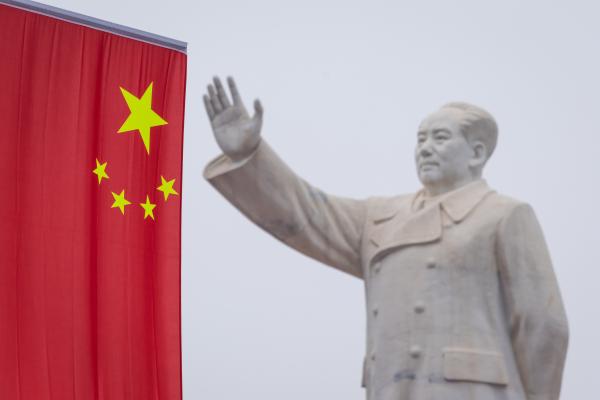
Join Dr. Miles Yu, senior fellow and director of Hudson’s China Center, for a conversation with Professor Xu on why misunderstanding China’s political order may create critical strategic risks for the US amid intensifying geopolitical rivalry.
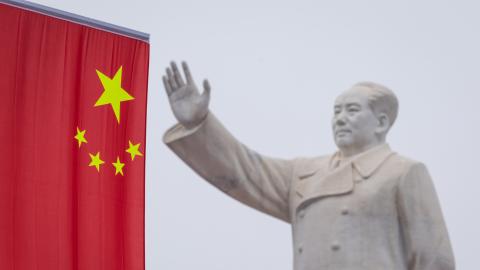

Join Hudson’s Peter Rough for a discussion with Wess Mitchell on the future of great power diplomacy.

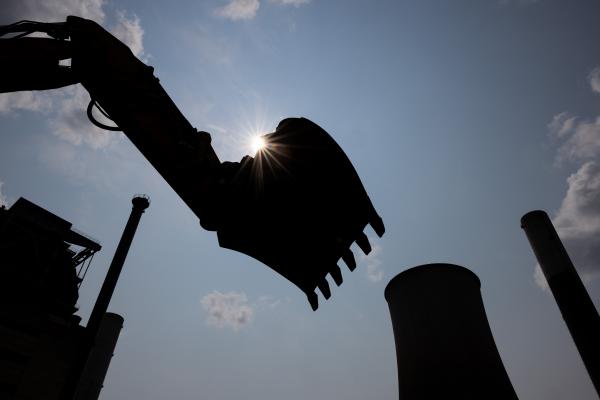
Join Hudson Institute for a conference on the future of America’s industrial base.














